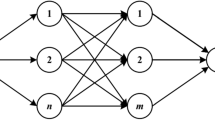Abstract
Based on the fact that the current neural network technology is difficult to find the high quality training sample data in the process of the private enterprise application, aiming at the present situation of the performance grading of the private enterprise, this paper puts forward the performance evaluation of the private enterprise, which is combined with the multilevel dynamic fuzzy evaluation and the BP neural Network, The evaluation model is established by artificial neural theory, and a decision support system for performance evaluation of private enterprises is established by using the multiple hidden layer neural network structure and the reverse propagation (BP) algorithm training network.


Similar content being viewed by others
Change history
13 December 2022
This article has been retracted. Please see the Retraction Notice for more detail: https://doi.org/10.1007/s11277-022-10131-3
References
Luo, H. W. (2012). Performance evaluation of China’s agricultural listed companies based on DEA model. Asian Agricultural Research, 5, 1–6.
Dey, P. K., Bhattacharya, A., & Ho, W. (2014). Strategic supplier performance evaluation: A case-based action research of a UK manufacturing organisation. International Journal of Production Economics, 166, 192–214.
Kang, J., Zhang, J., & Gao, J. (2016). Improving performance evaluation of health, safety and environment management system by combining fuzzy cognitive maps and relative degree analysis. Safety Science, 87, 92–100.
Gu, H. Q., Song, H., & Zhang, C. (2013). Study on supply chain performance evaluation method of equipment spare parts. Advanced Materials Research, 605–607, 553–556.
Du, L. Z., Wang, C. R., & Tao, D. X. (2013). The performance evaluate system of automotive supply chain. Applied Mechanics and Materials, 339, 766–771.
Owusu, G. (2007). AI and computer-based methods in performance evaluation of sporting feats: an overview. Artificial Intelligence Review, 27(1), 57–70.
Li, X., & Chen, D. S. (2014). Comprehensive evaluation of network information security based on dynamic fuzzy mathematics. Applied Mechanics and Materials, 701–702, 167–171.
Ahmed, I., Sultana, I., Paul, S. K., et al. (2013). Employee performance evaluation: A fuzzy approach. International Journal of Productivity & Performance Management, 62(7), 718–735.
Hu, J., Yang, X., & Ji, S. W. (2014). Data processing in performance evaluation of logistics park based on fuzzy comprehensive evaluation method. Applied Mechanics and Materials, 685, 735–739.
Hu, B. L., Xu, J. R., Gao, H. H., et al. (2013). Modified BP neural network model is used for odd-even discrimination of integer number. Applied Mechanics and Materials, 423–426, 2675–2678.
Ding, S., & Wu, Q. H. (2013). A MATLAB-based study on approximation performances of improved algorithms of typical BP neural networks. Applied Mechanics and Materials, 313–314, 1353–1356.
Wu, J. H., Wang, G. L., Wang, J., et al. (2011). BP neural network and multiple linear regression in acute hospitalization costs in the comparative study. Applied Mechanics and Materials, 50–51, 959–963.
Feng, F., Xu, S. G., Liu, J. W., et al. (2010). Comprehensive benefit of flood resources utilization through dynamic successive fuzzy evaluation model: A case study. Science China Technological Sciences, 53(2), 529–538.
He, J. L., & Shi, Z. K. (2013). Alarm the quickly changing of performance evaluation decisive indexes—qualitative to quantitative?[J]. Quality & Quantity, 47(1), 27–37.
Chen. D., & Li. X. (2012). A comprehensive evaluation model of network information security based on interval-valued fuzzy mathematics. In IEEE international conference on computer science & service system (pp. 777–780).
Jia, W., Zhao, D., Shen, T., et al. (2015). An optimized classification algorithm by BP neural network based on PLS and HCA. Applied Intelligence, 43(1), 1–16.
Delgado, M., Verdegay, J. L., & Vila, M. A. (1994). A model for linguistic partial information in decision-making problems. International Journal of Intelligent Systems, 9(4), 365–378.
Yang, Y., & Zhou, Y. (2011). Fuzzy logic based method for network information security risk assessment. In IEEE international conference on internet technology and applications (pp. 1–4).
Zheng, P., & Li, J. Q. (2010). A method of supply chain performance evaluation based on BP neural network. Operations and Management, 19(2), 26–32.
Zhang, J. (2011). Construction of virtual Enterprise performance evaluation model based on BP artificial neural network. Lanzhou: Lanzhou University.
Author information
Authors and Affiliations
Corresponding author
About this article
Cite this article
Shu, Y., Xu, Gh. RETRACTED ARTICLE: Multi-level Dynamic Fuzzy Evaluation and BP Neural Network Method for Performance Evaluation of Chinese Private Enterprises. Wireless Pers Commun 102, 2715–2726 (2018). https://doi.org/10.1007/s11277-018-5298-0
Published:
Issue Date:
DOI: https://doi.org/10.1007/s11277-018-5298-0




